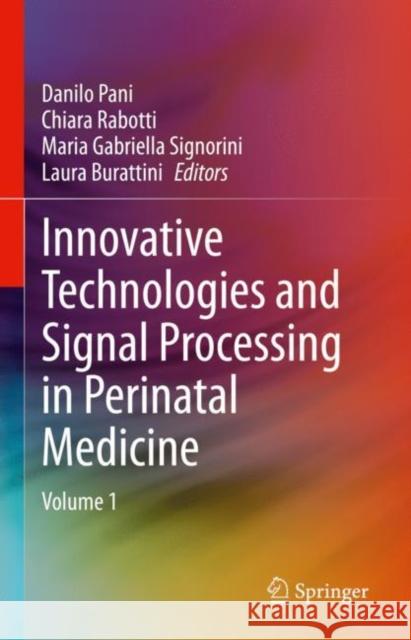Innovative Technologies and Signal Processing in Perinatal Medicine: Volume 1 » książka



Innovative Technologies and Signal Processing in Perinatal Medicine: Volume 1
ISBN-13: 9783030544027 / Angielski / Twarda / 2020 / 232 str.
Innovative Technologies and Signal Processing in Perinatal Medicine: Volume 1
ISBN-13: 9783030544027 / Angielski / Twarda / 2020 / 232 str.
(netto: 439,84 VAT: 5%)
Najniższa cena z 30 dni: 443,35
ok. 22 dni roboczych
Dostawa w 2026 r.
Darmowa dostawa!
Introduction.- Innovative Technologies for Intrauterine Monitoring of Predictive Markers of Vascular and Neurological Well-being.- Back to the Future: Prenatal Life and Perinatal Programming.- Fetal Cardiological Diagnostics in the Clinical Practice.- Real-time Telecardiology: Methods and Tools.- From Technology Innovation to Clinical Implementation – a Perspective From the Industry.- Fetal Cardiac Signal Processing Techniques.- T-wave Alternans Identification in Direct and Indirect Fetal Electrocardiography.- Ultrasound Imaging: From Physics to Fetal Anatomical and Functional Measurements.- Fetal Magnetocardiography.- Cardiotocography for Fetal Monitoring and Physiological Rationale Behind It.- Advanced Signal Processing and Modelling Techniques in Fetal Heart Rate Signal Analysis.- Intrapartum Fetal Heart Rate Analysis: From Fractal Features to Sparse Feature-selection Based Classification.- Monitoring Uterine Activity During Pregnancy and Delivery by Electrohysterography: Background, Modeling and Signal Analysis.- Innovative Devices and Techniques for Multimodal Fetal Health Monitoring.- Advanced Signal Processing Algorithms for Cardiorespiratory Monitoring in the Neonatal Intensive Care Unit
Danilo Pani, Ph.D., is Associate Professor of Bioengineering in the Department of Electrical and Electronic Engineering, University of Cagliari, Italy, where he also received his Ph.D. in Electronic and Computer Engineering. His research interests are in the field of real-time digital processing of bio-signals and medical devices. His main research achievements are in the areas of fetal ECG, textile electrodes, real-time embedded processing of signals from the peripheral nervous systems for motor neuroprostheses, and telehealth systems. He is currently professor of Electronic Signal Processing and Biomedical Instrumentation for the B.Sc. program in Biomedical Engineering. He is co-founder and treasurer of the IEEE Sensors Council Italy Chapter, a member of the board of the National Bioengineering Group, appointed expert for the Independent Ethics Committee of the University Hospital of Cagliari, and member of UNINFO Committee for Medical Informatics, and participates as Italian expert to CEN Technical Committee 251, WG 2 and the to some standard WGs. He is PI of the DoMoMEA project, and unit coordinator of the Flag-Era Convergence Project and the MIUR PRIN ICT4MOMs. He is the Chair of the first and second (upcoming in 2021) International Summer School on Technologies and Signal Processing in Perinatal Medicine.
Maria G. Signorini, Ph.D., is Associate Professor in the Department of Electronic, Information and Bioengineering at Politecnico di Milano, where she also received her Ph.D. in Biomedical Engineering. Dr. Signorini served as Coordinator of the Biomedical Engineering Ph.D. track at the Doctorate School of the Politecnico di Milano from 2004 to 2014. Her main research field is focused on improving healthcare paths and medical devices by introducing both new methodological approaches and technological solutions based on biomedical signal processing. Her activity is devoted to multiparameter approaches to integrating linear and nonlinear parameters towards the prediction of risk in antepartum fetal monitoring, premature babies, dialysis patients, and others cardiovascular diseases. Results of her research have been translated into technological solutions with modification of existing biomedical devices (Cardiotocography, Dialysis), and design of new instrumentation (wearable fetal HR monitoring, Since 2019, she has been PI of the project MIUR PRIN “ICT4MOMs. An ICT integrated approach to monitor and manage pregnancy development”.
Chiara Rabotti, Ph.D, is currently Senior Scientist at Philips Research. She obtained her Ph.D. from the Eindhoven University of Technology (TU/e) on the characterization of uterine activity by electrohysterography and an M.Sc. degree in Electrical Engineering at the University of Florence, Italy. Her research interests include electrophysiological signal processing and modelling with special focus on neuromuscular- and perinatal- related applications.
Laura Burattini, Ph.D., is currently an Associate Professor in the Department of Information Engineering of the Università Politecnica delle Marche, she teaches the courses of Bioengineering (Bachelor Degree) and Biomedical Signal and Data Processing (Master Degree), and is responsible of the Cardiovascular Bioengineering Lab. She received the Ph.D. in Electrical/Biomedical Engineering at the University of Rochester, and a Master degree in Electrical/Biomedical Engineering at the Politecnico di Milano (Itay). She contributed to found Bio-Medical Engineering Development srl, an academic spin-off where she served as CEO and President from 2012 to 2016. She is currently on the Editorial Board of The Journal of Electrocardiology and The Open Biomedical Engineering Journal. Her main research interests are processing of cardiovascular signals specifically for the identification of non-invasive indexes of cardiovascular risk. She is also active in fetal applications related to both fetal electrocardiography and cardiotocography.
Pregnancy is a critical time for the health of the mother and the fetus, with important potential risks for both. Tools for antenatal diagnosis and pregnancy monitoring can support prevention and management of potential risks and complications. In particular, the perinatal period, spanning from the third trimester of pregnancy up to one month after birth, is the most critical for the baby. For this reason, in the last decades, biomedical engineering supported and fostered the scientific research towards the identification of new models, parameters, algorithms, and tools that can improve the quality of fetal monitoring, predict the outcomes and allow physicians to intervene in an appropriate manner to ensure a healthy future for the baby. This book follows the First International Summer School on Technologies and Signal Processing in Perinatal Medicine and reflects some of its most important master lectures. It represents a valuable guide for students and young researchers approaching this topic for the first time, as well as experienced researchers and practitioners looking for a clear representation of the themes and techniques presented by recognized experts in the field.
- Presents current and innovative technologies for fetal and neonatal monitoring
- Emphasis on both technology/signal processing and clinical aspects
- Offers a clear didactic approach to the subject matter
1997-2025 DolnySlask.com Agencja Internetowa
KrainaKsiazek.PL - Księgarnia Internetowa









